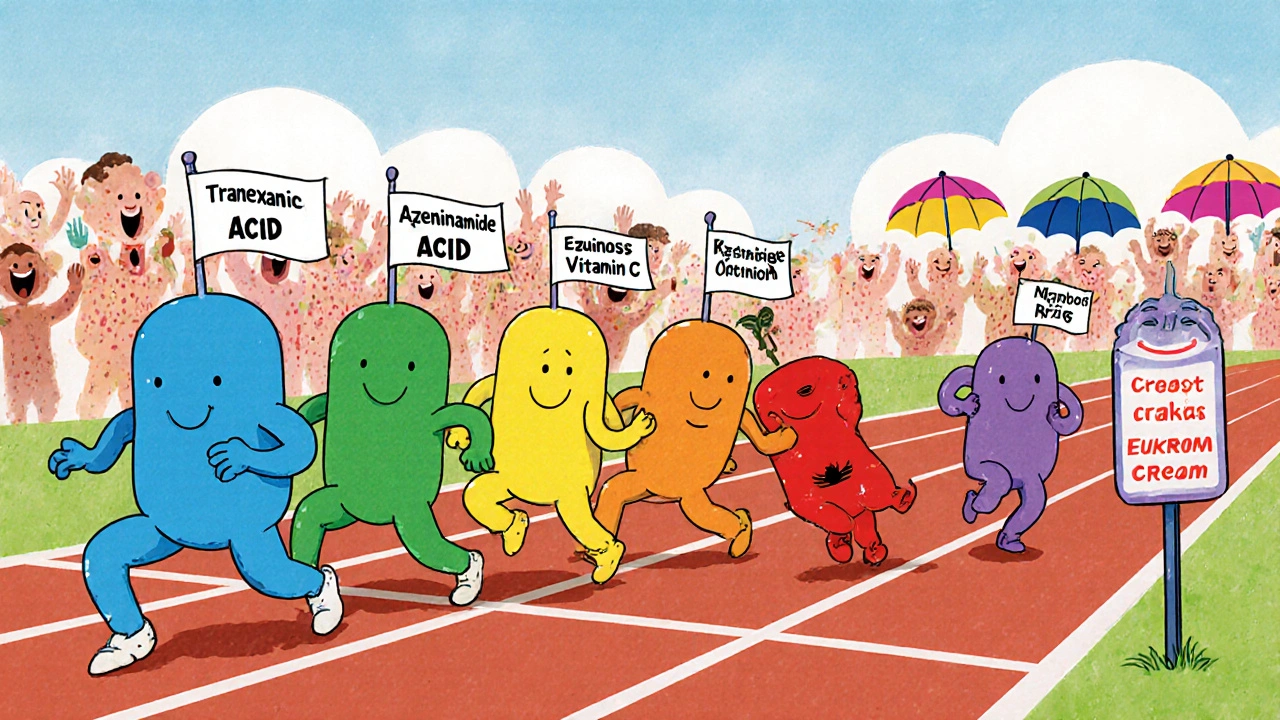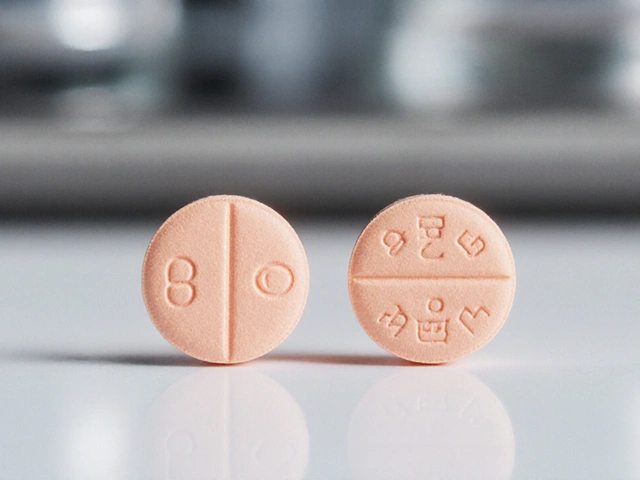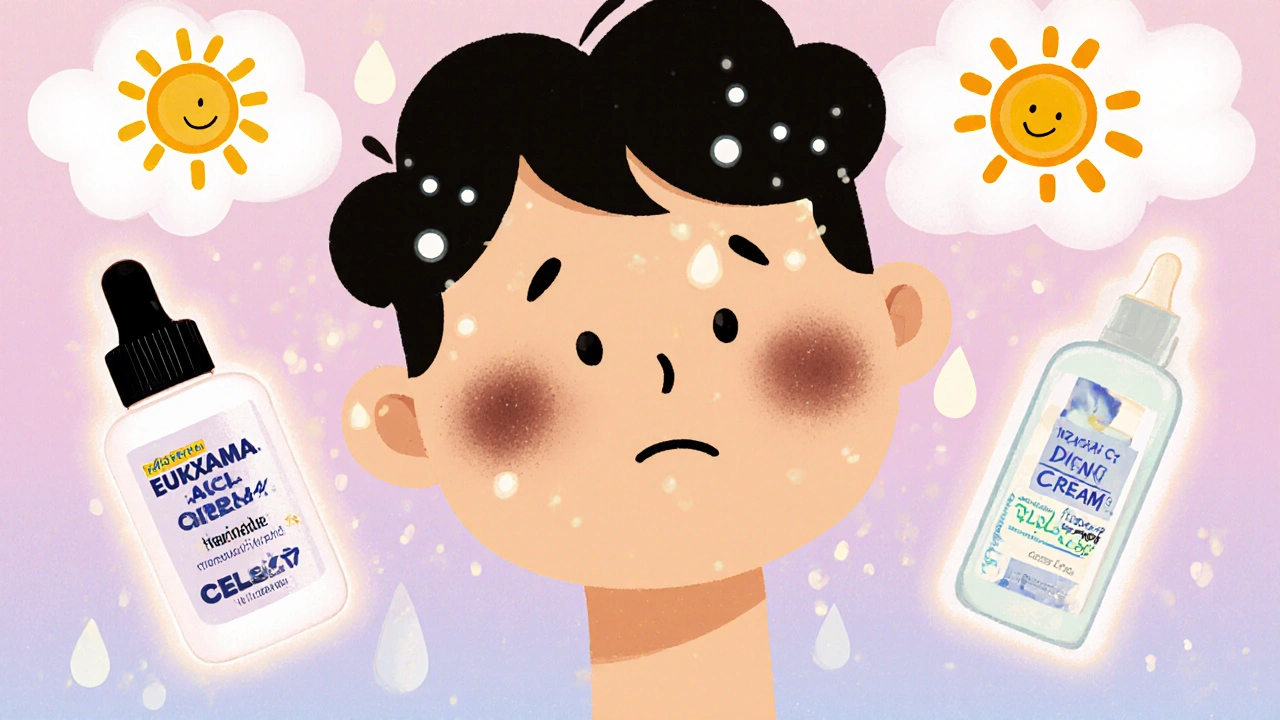Skin Lightening Alternative Finder
Find Your Best Skin Lightening Alternative
Choose your priorities to discover which skin lightening alternatives work best for your needs. Based on your selections, we'll recommend the most suitable options.
Select your preferences above to see recommendations
Dark spots, melasma, and post-acne marks don’t just fade on their own. For many people, Eukroma Cream - which contains 4% hydroquinone - has been a go-to solution. But it’s not the only option. And for some, it’s not even the best. If you’ve been using Eukroma Cream and noticed side effects, or if you’re worried about long-term safety, you’re not alone. Many are switching to alternatives that work just as well - without the risks.
What is Eukroma Cream, really?
Eukroma Cream is a prescription-strength skin lightener that contains 4% hydroquinone. Hydroquinone works by blocking the enzyme tyrosinase, which your skin uses to make melanin - the pigment that gives skin its color. Less melanin means lighter patches over time. It’s been used for decades to treat melasma, sun spots, and post-inflammatory hyperpigmentation.
But here’s the catch: hydroquinone isn’t a gentle ingredient. In the U.S., it’s still available by prescription, but the FDA has flagged safety concerns. Long-term use can lead to ochronosis - a rare but irreversible blue-black discoloration of the skin. It’s also banned in the EU, Australia, Japan, and several African countries. The World Health Organization recommends limiting hydroquinone use to 3 months at a time, then taking a break.
Most users see results in 6-12 weeks. But if you stop too soon, the dark spots come back. And if you use it too long, you might trade one problem for another.
Why people look for alternatives to Eukroma Cream
People stop using Eukroma Cream for several reasons:
- They develop redness, burning, or peeling
- They’re pregnant or breastfeeding and can’t risk hydroquinone
- They can’t get a prescription
- They’re worried about long-term damage
- They want something that works with their existing skincare routine
And here’s the truth: you don’t need hydroquinone to fade dark spots. Several alternatives have been proven in clinical studies to match or even outperform hydroquinone - without the same risks.
Top alternatives to Eukroma Cream
Let’s break down the most effective, science-backed options that actually work.
1. Tranexamic Acid (Topical)
Tranexamic acid started as a blood-clotting drug. Now, it’s one of the hottest ingredients in dermatology for pigmentation. A 2023 study in the Journal of the American Academy of Dermatology found that 3% topical tranexamic acid reduced melasma as effectively as 4% hydroquinone - but with fewer side effects.
It works differently: instead of killing pigment cells, it blocks the signals between skin cells and melanin-producing cells. That means less irritation and no risk of ochronosis. Brands like The Ordinary and SkinCeuticals offer tranexamic acid serums. You can use it daily, even long-term.
2. Kojic Acid
Kojic acid comes from fermented rice. It’s been used in Asian skincare for centuries. It inhibits tyrosinase, just like hydroquinone - but more gently. A 2020 study showed that 2% kojic acid combined with 2% arbutin improved pigmentation by 60% after 12 weeks.
It’s not as strong as hydroquinone, but it’s safe for sensitive skin and doesn’t cause ochronosis. You’ll find it in products like Mizon’s Kojic Acid Serum and some Korean brightening creams. Use it with sunscreen - it can make skin more sun-sensitive.
3. Azelaic Acid (15-20%)
Azelaic acid is a naturally occurring acid found in grains. The prescription version (Finacea, Azelex) is 15-20% and FDA-approved for rosacea and hyperpigmentation. A 2021 trial compared 20% azelaic acid to 4% hydroquinone in 120 patients. Both reduced spots by about 70%, but azelaic acid caused less irritation and redness.
It’s also anti-inflammatory, which helps with acne-related dark marks. It’s safe during pregnancy and breastfeeding - something hydroquinone can’t claim. You’ll need a prescription for the higher strength, but lower concentrations (10%) are available over the counter.
4. Niacinamide (Vitamin B3)
Niacinamide isn’t a bleaching agent. Instead, it stops melanin from transferring to skin cells. Think of it as blocking the delivery truck, not destroying the pigment factory.
A 2019 study in the Journal of Clinical and Aesthetic Dermatology showed that 4% niacinamide was as effective as 4% hydroquinone for melasma after 8 weeks - and better tolerated. It’s also hydrating, reduces redness, and strengthens the skin barrier.
It’s in tons of affordable products: CeraVe PM Moisturizer, Paula’s Choice 10% Niacinamide Booster, and even some drugstore brands. You can layer it with retinoids, vitamin C, and sunscreen - no downtime.
5. Vitamin C (L-ascorbic acid)
Vitamin C is an antioxidant that fades dark spots by neutralizing free radicals and inhibiting melanin production. A 2020 review in Photodermatology, Photoimmunology & Photomedicine found that 15-20% L-ascorbic acid improved pigmentation in 70% of users after 16 weeks.
It’s not as fast as hydroquinone, but it’s safe for daily use and adds anti-aging benefits. Look for serums with ferulic acid and vitamin E - they stabilize vitamin C and boost its effect. SkinCeuticals C E Ferulic is the gold standard, but The Ordinary’s 23% solution works too if you can tolerate it.
6. Retinoids (Tretinoin, Adapalene)
Retinoids speed up skin cell turnover. That means dark spots get sloughed off faster. Tretinoin (prescription) and adapalene (over-the-counter, Differin) both improve pigmentation when used consistently.
A 2018 study found that combining 0.05% tretinoin with 4% hydroquinone worked better than hydroquinone alone. But even tretinoin alone improved melasma by 50% after 24 weeks.
It takes patience - you’ll see results in 3-6 months. But it also helps with fine lines and texture. Start slow: every other night, with a moisturizer to reduce dryness.

Comparison table: Eukroma Cream vs. top alternatives
| Product/Ingredient | Strength | Time to Results | Side Effects | Safe During Pregnancy? | Available Over-the-Counter? |
|---|---|---|---|---|---|
| Eukroma Cream | 4% hydroquinone | 6-12 weeks | Redness, peeling, ochronosis (long-term) | No | Prescription only |
| Tranexamic Acid | 3-5% | 8-16 weeks | Mild irritation | Yes | Yes |
| Kojic Acid | 1-2% | 12-16 weeks | Sun sensitivity | Yes | Yes |
| Azelaic Acid | 15-20% | 8-12 weeks | Mild stinging | Yes | Prescription only (higher strength) |
| Niacinamide | 4-10% | 8-12 weeks | Very rare | Yes | Yes |
| Vitamin C (L-ascorbic) | 15-20% | 12-16 weeks | Stinging if pH too low | Yes | Yes |
| Tretinoin/Adapalene | 0.025-0.1% | 3-6 months | Dryness, flaking | Yes (adapalene) | Adapalene: yes; Tretinoin: no |
What works best in combination?
Single ingredients rarely give the best results. Dermatologists use combinations because they target pigmentation in different ways.
Here are three proven routines:
- For sensitive skin: Niacinamide (AM), tranexamic acid (PM), sunscreen daily.
- For stubborn melasma: Azelaic acid (AM), retinoid (PM), sunscreen. Add vitamin C 2-3x/week.
- For budget-friendly brightening: Kojic acid serum (AM), vitamin C (PM), sunscreen. Use every other day at first.
Always use sunscreen - no matter which product you choose. UV exposure is the #1 reason dark spots come back. Use SPF 30+ daily, even indoors. Reapply every 4 hours if you’re outside.

When to see a dermatologist
Most of these alternatives are safe to try on your own. But see a dermatologist if:
- Your dark spots spread or change shape
- You get itching, swelling, or blisters
- Nothing improves after 16 weeks
- You have a history of skin cancer
A dermatologist can prescribe stronger formulations, do chemical peels, or recommend laser treatments if needed. They can also test if your pigmentation is actually melasma, post-inflammatory hyperpigmentation, or something else - like a benign mole that needs monitoring.
Final advice: Don’t rush, don’t overdo it
Hydroquinone works fast - but fast doesn’t mean better. Many people burn out their skin chasing quick results. The truth? Skin lightening is a marathon, not a sprint.
Alternatives like tranexamic acid, niacinamide, and azelaic acid take longer - but they’re safer, gentler, and sustainable. You can use them for months or even years without worrying about damage.
Choose one alternative to start with. Stick with it for 12 weeks. Add sunscreen. Be patient. Your skin will thank you.
Is Eukroma Cream safe for long-term use?
No. Long-term use of Eukroma Cream (more than 3-6 months) carries a risk of ochronosis - a rare but permanent blue-black discoloration of the skin. Most dermatologists recommend using it only for short cycles, with breaks in between. Many patients switch to safer alternatives like tranexamic acid or azelaic acid for ongoing maintenance.
Can I use hydroquinone and niacinamide together?
Yes, but it’s not necessary. Hydroquinone and niacinamide work in different ways, so combining them can enhance results. However, since niacinamide alone can be as effective as hydroquinone for many people, and without the risks, most dermatologists now recommend using niacinamide on its own - especially if you’re concerned about side effects.
What’s the fastest way to fade dark spots without hydroquinone?
The fastest non-hydroquinone option is a combination of 20% azelaic acid and a retinoid like adapalene. Studies show this duo can reduce melasma by 60-70% in 12 weeks. For faster results, some dermatologists combine this with chemical peels - but that requires professional supervision.
Are natural alternatives like lemon juice or turmeric effective?
No. Lemon juice is highly acidic and can cause severe irritation, burns, and increased sun sensitivity. Turmeric has mild anti-inflammatory properties but doesn’t significantly reduce melanin. These are not scientifically proven alternatives and can damage your skin barrier. Stick to ingredients with clinical backing: tranexamic acid, niacinamide, azelaic acid, etc.
Why does my dark spot come back after I stop using Eukroma Cream?
Hydroquinone suppresses pigment production but doesn’t remove the underlying cause - like sun exposure or hormonal triggers. Once you stop, your skin resumes making melanin. To prevent rebound, you need ongoing maintenance with a gentler ingredient like niacinamide or tranexamic acid - and daily sunscreen. Stopping treatment without a plan is the #1 reason dark spots return.






14 Comments
I tried Eukroma for 3 months and my face looked like a bruised plum 😭😭😭 Now I use niacinamide and my skin’s actually glowing?? Who knew??
Hydroquinone is a scam. Big pharma made it legal so you’d keep buying it. Look at the EU ban. They know what’s up.
I swear someone put something in my water because my melasma came back worse after I stopped Eukroma. I think the government is testing skin lighteners on us. I’m not crazy. I’ve seen the videos.
I use azelaic acid now. Simple. Works. No drama.
Y’all need to stop being scared of skincare! I went from dark spots to even tone in 10 weeks with tranexamic acid + sunscreen. You got this! 💪✨
If you’re using hydroquinone and not wearing SPF 50 every single day, you’re basically painting your face with a highlighter for UV damage. Seriously. Sunscreen isn’t optional-it’s the foundation. I’ve seen clients go from ochronosis to clear skin with just azelaic acid + niacinamide. No drama, no fear, just consistency. Start slow, stay patient, and don’t let TikTok dermatologists scare you. You don’t need a miracle. You need a routine.
Hydroquinone is banned in 20+ countries. Why? Because it’s toxic. The FDA? They’re paid off. You think they care about your skin? They care about profits. Read the studies. Don’t trust the ads.
The real question isn’t which ingredient works-it’s why we’re so obsessed with lightening skin at all. Is it beauty? Or is it internalized racism dressed up as skincare? I’ve seen people ruin their barrier chasing a complexion they were never meant to have. Maybe the real treatment is self-acceptance.
I used to think vitamin C was just a trend until I saw the clinical data. The fact that it reduces oxidative stress AND fades spots? That’s not luck. That’s science. But most people use the wrong formulation-low concentration, unstable, no ferulic acid. You’re wasting your money.
The notion that alternatives are 'safer' is statistically misleading. The incidence of ochronosis is less than 0.1% in controlled use. Meanwhile, the overuse of unregulated kojic acid products has led to increased cases of contact dermatitis. Regulatory caution does not equate to clinical necessity.
I tried tranexamic acid and my skin broke out like I was in high school again. I think they’re hiding something. Why is it so expensive? Who’s making money off this? I don’t trust it. I’m going back to Eukroma. I don’t care what they say.
I just wanted to say thank you for this post. I’ve been using azelaic acid for 4 months and my post-acne marks are barely visible. I didn’t think I’d ever feel confident again. You’re not just sharing info-you’re helping people heal.
Nigeria has the best skin in the world. We don’t need your creams. We have natural oils. You Westerners are too obsessed with being pale. Embrace your melanin. 🇳🇬🔥
The pursuit of skin lightening reflects a deeper cultural pathology wherein epidermal tone becomes a proxy for social value. The substitution of hydroquinone with tranexamic acid does not resolve the ontological crisis of self-worth tied to pigmentation. True liberation lies not in chemical intervention but in the dismantling of aesthetic hegemony